Most Common Ice Hockey Penalties
From the penalty box to the penalty shot
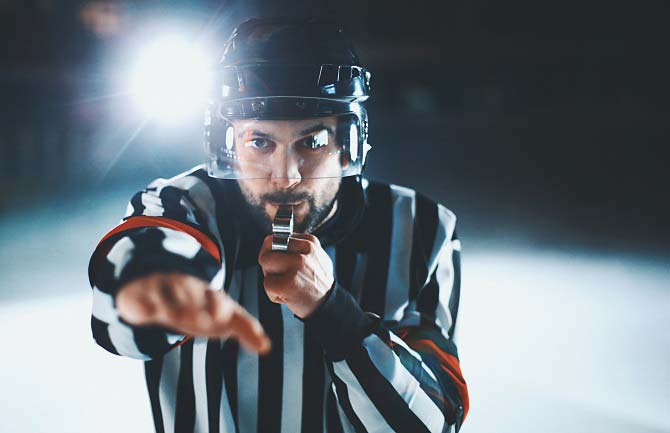
When is a penalty in ice hockey given? And what punishment does a cross check actually entail? Not only do we explain what hockey penalties there are and what the most common hockey fouls are, but we also tell you about penalty records!
In the following article we explain the ice hockey penalties established by the International Ice Hockey Federation (IIHF). The basis of this article is the IIHF Official Rule Book 2018-2022.
What kind of ice hockey penalties are there?
Depending on which offense a player commits, one of the following penalties may be imposed.
Important first: A goalkeeper never goes in the penalty box. If a goalkeeper receives a penalty, another player who was on the ice at the time of the offense must serve it for him. Exceptions are the misconduct and match penalty or an ejection: If a goalkeeper receives such a penalty, he must leave the ice and a substitute goalkeeper is brought in.
Minor Penalty
- Penalty Duration: 2 minutes
- IIHF Rule: 501
- Example Offences: interfering the goalie, high stick or tripping
- Description: Punishment for a minor offence
- Man Advantage: The team with the penalty is down a man for 2 minutes. After 2 minutes, he returns to the ice. The penalty is cut short if the opposing team scores a goal.
- Additional Info: When the goalie receives a penalty, another player who was on the ice must take the penalty in his place.
Bench Minor
- Penalty Duration: 2 minutes
- IIHF Rule: 502
- Example Offences: Delay of game or too many men on the ice.
- Description: Punishment for team offense that disrupts the flow of the game.
- Man Advantage: The penalised team plays with 1 less skater for 2 minutes. After 2 minutes, he returns to the ice. The penalty is cut short if the opposing team scores a goal.
- Additional Info: The penalty is not directed at a single player, but against the entire team. This means that no specific player is penalised. The coach decides which player goes into the penalty box.
Major Penalty
- Penalty Duration: 5 minutes
- IIHF Rule: 503
- Example Offenses: Boarding, charging, cross-checking
- Description: When a player commits a major penalty, he is penalised for 5 minutes.
- Man Advantage: The team with the penalty is down a man for 5 minutes. After 5 minutes, he returns to the ice. The penalty remains in effect even if the opposing team scores a goal.
- Additional Info: Goalies are excluded from this penalty. If a player commits 2 major penalties in a game, the player may be subject to suspension and is thrown out of the game.
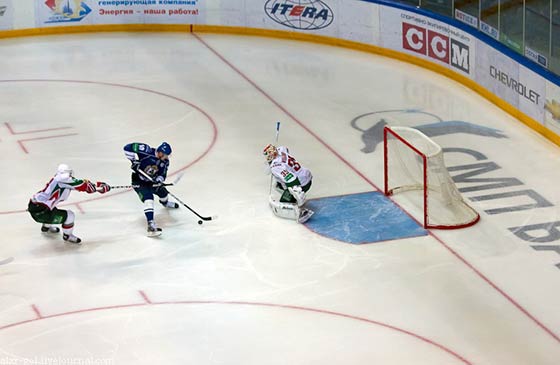
Credit: Alexander Golovko [CC BY-SA 3.0 (https://creativecommons.org/licenses/by-sa/3.0)], via Wikimedia Commons
Misconduct Penalty
- Penalty Duration: 10 minutes
- IIHF Rule: 504
- Example Offences: Abuse of officials, unsportsmanlike conduct
- Description: With this penalty, the player must leave the ice for 10 minutes and remain on the bench until the next stoppage.
- Affect on Game: The player can be replaced immediately by another player. There is no man advantage for the team.
- Additional Info: For certain offences (e.g. check to the head, checking from behind), referees usually impose a minor penalty in addition to the misconduct penalty. An extra player must sit in the penalty box for the minor penalty while the original offender must remain on the bench for the 10 minutes. If a player receives a two misconduct penalties in one game, he is ejected.
Game Misconduct
Gross Misconduct Penalty
- Penalty Duration: Game ejection
- IIHF Rule: 506
- Example Offences: Abuse of officials, spats with spectators, alcohol consumption before or during the game, verbal abuse, discrimination
- Description: Immediate ejection.
- Affect on Game: The ejected player is replaced on the ice. There is no man advantage given.
- Additional Info: The NHL removed the gross misconduct penalty from the rulebook and replaced it with the game misconduct penalty.
Match Penalty
- Penalty Duration: Immediate ejection + 5 minutes for a teammate
- IIHF Rule: 507
- Example Offences: Serious offences such as attempted headbutt or kicking
- Description: The referee may impose a match penalty on a player or goalkeeper who intentionally injures or attempts to injure another player. The player will be disqualified for the rest of the game and sent to the dressing room.
- Man Advantage: A substitute player must go to the box for 5 minutes. After that, he may return to the ice.
- Additional Info: -
Penalty Shot
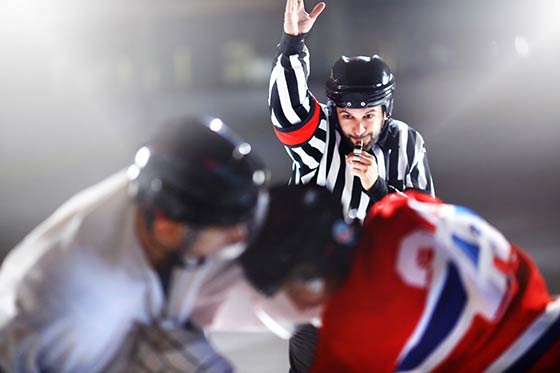
List of the most common penalties
The following is a selection of the 55 different offenses listed in the IIHF rules and regulations.
- Boarding
- Interference
- Checking from behind
- Checking to the head
- Elbowing
- Hooking
- Holding
- Holding the Stick
- High Sticking
- Headbutt
- Abuse of Officals
- Cross-checking
- Roughing
- Charging
- Unsportsmanlike Conduct
- Too Many Men
Boarding
Interference
Checking from behind
Major penalty, ejection or match penalty: If a player negligently endangers another player through his misconduct.
20 game suspension: Tom Kühnhackl
In a game between the Niagara IceDogs and the Kitchener Rangers in 2011 Ice hockey legend Tom Kühnhackl races into opponent Brian Murphy. Murphy, who played for the Kitchener Rangers, suffers a severe concussion during the impact and remains on the ice before leaving visibly dazed. Here you can have a look yourself:
Kühnhackl was ejected from the game. He was subsequently suspended for 20 games due to the injury to the head he caused.
Checking to the Head and Neck
Elbowing
A major, misconduct or match penality is imposed if a player negligently risks the health and welfare of an opponent.
Hooking
Holding
Holding the Stick
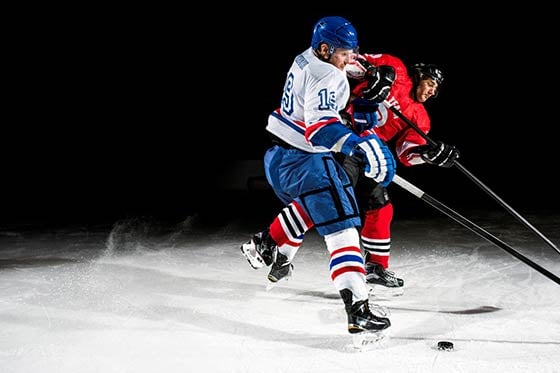
High Stick
Double Minor Penalty: A player accidentally injures an opponent with a high stick.
Major penalty, match penalty or ejection: A player negligently risks injury of an opponent.
Headbutt
Abuse of Officials
- IIHF Rule: No. 116
- Description: Abuse of officials occurs when a player physically confronts or openly questions a referee's authority.
- Penalty: Depends on the severity. Minor Penalty: Using your stick to strike against the glass in order to protest or insult the referee's decision.
- Match Penalty: Violence against a referee or injury to the referee; volleying or throwing the stick or puck at the referee; threating, discriminating, spitting or smearing blood at the referee by a player or team official; obscene language or gesture of a player or team official to the referee before, during or immediately after play.
- Additional Info: If obscene language or behaviour occurs on or off the ice after the match, the referee may impose a suspension.
Penalty: The team or player or official insults a referee; a punished player refuses sit in the penalty box; physically protesting the referee's ruling; use of video material to challenge referee ruling.
Disciplinary Penalty: A player requests or uses video footage to challenge a referee's verdict; intentionally pushes the puck away from the ref; a player comes too close to the referee; a (co-)captain complains to a referee about the conduct and verdicts of another referee; an already-penalised player does not immediately go to the penalty box.
Game Misconduct: Use of offensive language or obscene behavior after a minor penalty has been imposed; disrespectful or violent behavior toward a referee by a player or team official; throwing an object at a referee or spraying the referee with a water.
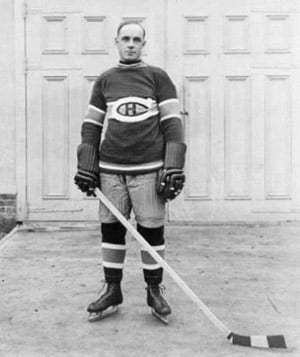
Life ban in the NHL: Billy Coutu
In the Stanley Cup playoffs, Billy Coutu, the Boston Bruins left wing, beat referee Jerry LaFlamme. As a result, he was banned from the National Hockey League (NHL) for life. This was the first and only lifetime ban ever imposed in the NHL. The defender then moved to the Canadian-American Hockey League and ended his career there in 1934.
Cross-checking
Roughing
Striking the opponent's head: minor penalty
Charging
Unsportsmanlike Conduct
- IIHF Rule: No. 168
- Description: Unsportsmanlike conduct is when a player or official violates the rules of sportsmanship, fair play and respect.
- Punishment: Depends on severity.
- Minor Penalty: refers primarily to clearly identifiable players; when offensive language or behaviour is used towards teammates, opponents or spectators, cheers for fouls or injuries, spraying ice on the opposing goalkeeper when braking.
- Bench minor: refers to unidentifiable players or the entire team; for when a team member or official behaves in an unsportsmanlike manner, uses obscene or abusive language or conduct, celebrates fouls or injuries, throws a stick or other object at the ice to protest.
- Misconduct: Is imposed when a player shoots the puck after a whistle from the referee, in apparent misconduct, or if a player continues to misbehave, when a player instigates an opponent to commit a foul, or when a player intentionally enters the bench area of the opposing team.
- Game Misconduct: Is pronounced if a player or official does not cease misconduct, such as the use of obscene or offensive language, even after a minor penalty or a bench sentence.
- Match Penalty: Imposed when a player or official uses racist, sexist or threatening language, spits or wipes blood on someone, usage of obscene gestures or conduct towards people on the ice, in the bank or spectator area before.
- Additional Info: -
Stephan Daschner, longest penalty recorded in the DEL
Ice hockey player Stephan Daschner from the Hannover Scorpions is currently defending the DEL league record for the longest penalty. Background: In a match between the Hannover Scorpions and the Straubing Tigers in 2012, Daschner racked up the longest penalty ever recorded. The referees Daniel Piechaczek and Simon Aicher imposed a penalty of 59 minutes, with Daschner holding the record for the longest penalty in DEL history.
Too Many Men
- IIHF Rule: No. 166
- Description: A team may only have six skaters on the ice. As soon as a team has 7 or more skaters, a penalty is called for too many men on the ice. A player may only enter the game if the player leaving the ice is 5 feet or less away from his own bench.
- Punishment: 2 minute minor
- Additional Info: -
Cheer on your favourite team with your own jersey
Ice hockey is a sport with a lot of body contact and can seem quite harsh. Nevertheless, the players are actually well protected, not only from padding but also strict rules. This is why many players still play into their 40s.
Now that you know all the hockey penalties, all you need is the right jersey to cheer on your favourite team or even play in yourself: In our online shop you can design your personal ice hockey jersey with our 3D Kit Designer - according to your individual preferences! In our online shop you will also find further ice hockey products, for which we regularly offer discounts!
We look forward to your orders!
These articles might also interest you:
Picture credits: Cover image: © gettyimages/gorodenkoff, Image 1: © Wikimedia Commons/Alexander Golovko (Licence: CC BY-SA 3.0), Image 2: © gettyimages/gilaxia, Image 3: © gettyimages/vm, Image 4: © Wikimedia Commons/unknown.